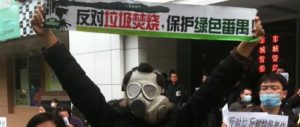Early this year, Lin Yong and his wife Wei Hua (not their real names) bought a three-bedroom apartment in the Lingxiu New Silicon Valley development in the Xierqi area of Beijing. By November 30, they were gearing up to take possession of their new home, but they weren’t feeling excited.
Xierqi lies outside Beijing’s fifth ring road – more than 10 kilometres from the city centre – but as lots of technology companies are based near here it has become a popular residential area. Apartments in Lin and Wei’s development go for up to 26,000 yuan (US$4,088) per square metre.
In early November, the local authority included construction of a “Xierqi kitchen-waste collection and utilisation centre” in its 2011 green action plan for Haidian district. Once built, it will handle 200 tonnes of kitchen waste a day. Quickly news spread that the local government was going to build a “rubbish dump” in Xierqi, igniting debate in community forums.
On the evening of November 9, some 200 residents gathered by Xierqi’s main street. Several handed out flyers reading “No to Cancer! No to Death!”, while petitions were passed around and rapidly filled. At about 8pm, the crowd of residents moved onto the road, at their helm a group of children in school uniform holding a banner with the message: “Fight the waste-handling plant in Xierqi”. Both children and adults chanted “No to rubbish! Give back the green!” The protest, which the residents claim was merely a group walk, lasted half an hour before the police persuaded the participants to disperse.
Ren Lianhai is an assistant professor at Beijing Technology and Business University’s Department of Environmental Science and Engineering. His research has found that a medium-sized hotel produces about 400 kilograms of kitchen waste a day, 50% of which is waste from cooking or leftovers. Beijing as a whole produces about 1,300 tonnes of kitchen waste a day.
Beijing’s official waste processing facilities are nowhere near adequate to deal with these numbers. Yu Jiayi, deputy general manager of the Xierqi facility’s operator Beijing Goldenway Biology Tech, said a lot of waste is mishandled and disposed of in an ad hoc fashion. The slops from many restaurants end up being taken to illegal pig farms, giving rise to food safety issues such as the spread of disease or the production of fake “gutter” cooking oil.
Yu said that, on completion, their facility in Xierqi will turn kitchen waste into humic acid to be used alongside fertiliser to improve soils. The entire process is sealed, he said. “Kitchen waste brought in will be processed within half an hour. . .no harmful gases will be released.”
Beijing Goldenway plans to build its factory partially underground and cover it with greenery, so that it will be well hidden. According to the plans, it won’t look so different from the green parks the developers promised Lin Yong when he bought his apartment.
But on November 13, after repeated questioning by nearby residents at a seminar on achieving public participation in the project, a solid waste management official from the Beijing Municipal Commission of City Administration and Environment admitted that there is a risk of foul smells from the handling of kitchen waste.
What makes Lin and other locals even more upset is that they have consistently been kept in the dark. After learning of the plans, representatives of the property owners contacted the body that carried out the environmental impact assessment and the contractors who will build the project and found that a public announcement had in fact been made – but in such a way that none of the residents knew about it.
The Xierqi incident is far from an isolated example. In Beijing alone there has been fierce opposition to construction of waste facilities in Gao’antun, Liulitun and Asuwei. Zhu Dajian, director of Tongji University’s Sustainable Development and Management Institute, told New Century Weekly that the increasing amount of opposition to waste facilities in China are classic examples of nimbyism.
Nimbyism comes from the acronym NIMBY, standing for “not in my back yard”, a phrase that first emerged in Europe and the United States in the last century, thanks to frequent and fierce local opposition to municipal projects such as waste facilities. It came to mean an attitude of resistance aimed at protecting one’s living space from the negative impacts of public or industrial infrastructure. In Chinese, nimby is transliterated as línbì (邻避).
Nimbies usually object to infrastructure that will have negative external effects and reduce people’s willingness to live nearby, such as waste facilities, nuclear power plants and chemical factories, as well as psychiatric facilities, prisons and funeral parlours.
In Europe and America, nimbyism has to an extent led to improvements in governance and public participation. For example, it would be impossible for residents to be unaware of a new waste facility in their neighbourhood, like the locals at Xierqi were. “If a waste facility was being built, there would be more widespread announcements for residents and a hearing to gather public views,” said Zhu Dajian. “Anyone who wanted to attend the hearing could do so: it wouldn’t be restricted to so-called residents’ representatives.”
Asia’s first encounter with nimbies was in Japan, closely followed by other economically developed regions such as Hong Kong and Taiwan. Taiwanese nimbyism already has a 33-year history. Early activists opposed small and medium-sized factory projects, later linking up with more widespread social movements that transformed the island.
Qiu Changtai, professor at National Taiwan University’s Department of Public Administration and Policy, said that as the Taiwanese government now operates in a way that lets the public express their demands within the rules of the game, there is much less of this kind of activism.
One of the reasons behind the change is Taiwan’s Environmental Impact Assessment Law. This covers procedures for openness of information and public participation. If a company fails to make the necessary information about a project public, it has broken the law and work on the project has to stop.
Qiu added that project developers in Taiwan often provide facilities such as parks, libraries, sports centres and heated swimming pools in order to compensate for unwanted infrastructure. Cuts in electricity costs or land tax breaks are also used to appease affected locals.
Chen Liwen, a researcher at Chinese NGO Green Beagle who organised the seminar in Xierqi, said the case reflects a lack of public participation in environmental impact assessments in China. “A major reason that the Xierqi residents were unhappy was that they didn’t know about the first stage assessment. The scope of publication by the authorities is too narrow – nobody will just visit their website to check,” said Chen.
Zhu Dajian’s view is that the interests of local people are often not sufficiently taken into account when undesirable facilities are being constructed. “The government looks after the interests of the majority, and takes it for granted that a minority should make sacrifices … decisions are made behind closed doors, announcements are limited and when the public objects, the government avoids the issue – and so it gets worse.”
To properly resolve the issues, said Zhu, the decision-making process needs to be transparent and safeguarded. But, he added, the Chinese government does not yet take nimbyism seriously enough – it does not realise how common a phenomenon it is. It may become a major form of social unrest, and the government is not good at dealing with that kind of conflict.
Chinese nimbies are becoming more prominent as the country continues its urban explosion and seem unlikely to disappear soon. “Municipal infrastructure is going to expand,” said Zhu. “There are going to be more subways – and more waste facilities.”
Cui Zheng is a reporter at New Century Weekly, where this article was first published.
Homepage image by focus.cn blogger 莞城达人



